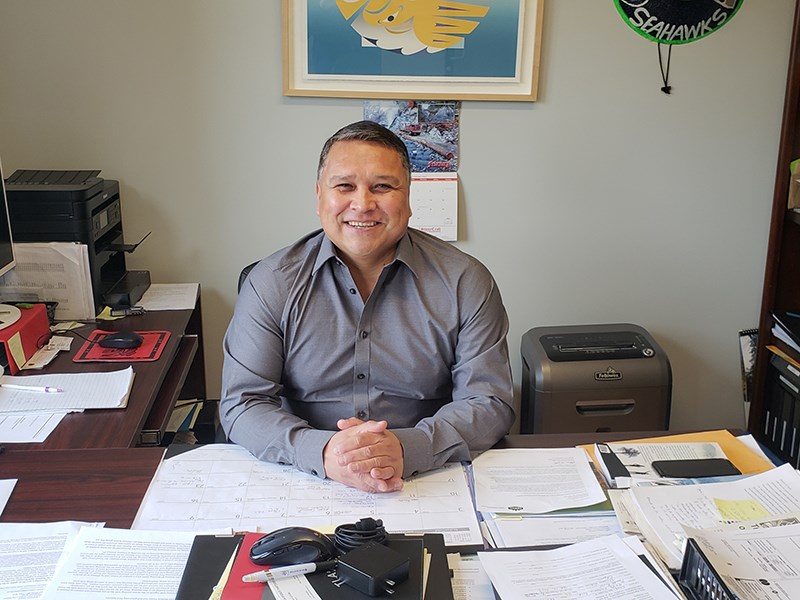The new Texada Island Economic Development Action Plan completed in 2018 includes a proposal for having a rendition of a longhouse built at ly’som, also known as Shelter Point Regional Park.
The location of the Shelter Point site was occupied by indigenous people from at least 3,300 years ago to just before contact with colonists, according to an archeological study.
After the Shelter Point concession stand was destroyed by fire in 2013, the plan was to rebuild it until midden was struck while digging the foundation, according to Tla’amin Nation hegus Clint Williams. The discovery immediately triggered the archeological impact assessment.
“That archeological assessment showed there were thousands of years of use of the land in the area,” said Williams. “Trying to acknowledge the Tla'amin people and Coast Salish people, the [qathet] Regional District were asking us what could they do there.”
Williams said the nation suggested a longhouse type structure for people to gather and pay respect to the land and the people from the past.”
Middens are protected if they contain artifacts, features, materials or other physical evidence of human habitation or use before 1846. Protection means a permit is required to alter the site and a request is in, according to Texada Island Chamber of Commerce president Cindy Babyn. If approved in the next six to eight weeks, this permit will be active until October 27, 2020.
At qathet Regional District (qRD) Committee of the Whole on Thursday, February 14, Babyn gave regional directors an update on efforts to build the structure.
According to Babyn, the chamber met with Tla’amin and representatives of qathet last year when the chamber expressed its primary goal was to begin discussions with Tla’amin to determine if it had any economic development plans on the island.
“The chamber understood that Tla’amin Nation feels that a longhouse project could bring a potential economic benefit to Texada by increasing tourism,” stated Babyn in a letter to Williams and the nation’s executive council. “More importantly, though, a project such as this would increase local and visitor awareness of Tla’amin Nation’s history on Texada.”
Babyn also said she understood that Tla’amin thinks qRD should pay for construction of the longhouse because it owns the Shelter Point Regional Park land. Williams said he agrees.
“It's their land and they're the ones who approached us about trying to pay respect to the land and people of the past,” said Williams. “It’s not high on our spending priorities list but the regional district has offered to pay for it in the past.”
In 2018 the capital cost of the project was estimated at $116,000, according to qRD manager of financial services Linda Greenan. “It was included in draft one of the 2018 Regional Parks budget but was removed in draft two in an effort to keep the requisition down,” she said.
Williams, a lifelong resident of Tla’amin and Powell River, said he grew up hearing of a myth people told as to why there were no first nations people on Texada. As the story went, indigenous people were afraid Texada would flip over or sink, according to Williams. He said the longhouse project would go far in dispelling that through the opportunities it would bring for interpretive education and awareness of the indigenous heritage of Shelter Point.
“The archeological study that found all of these thousands of years of land use really puts to bed that myth and that actually makes me quite happy to show that our people were there,” said Williams. “We knew that already. We have maps of fishing camps that were on the island.”
Babyn cited conversations she had with archeologist Colleen Parsley, who completed a study of Shelter Point in 2013 after the midden was discovered.
“This area was clearly a village consisting of several longhouses and may represent the best preserved example of village cultural topography that survives on the south coast,” concluded Parsley.
Parsley said she collected a total of 279 lithic artifacts, 195 animal and other remains and 15 historic artifacts during the study. A hearth feature was identified within the proposed development area and was dated to approximately 800 to 870 in conventional radiocarbon years. She concluded that the artifact assemblage suggests the Shelter Point site was occupied from at least 3,300 years to just before contact with colonists.
Regional district chair and Electoral Area A director Patrick Brabazon moved staff to return a report stating the exact status of the proposal from the regional district and Tla'amin perspective.



